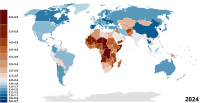
Photo from wikipedia
Abstract Objectives To compare screw‐retained and cemented all‐ceramic implant‐supported single crowns regarding biological and technical outcomes over a 5‐year observation period. Materials and methods In 44 patients, 44 two‐piece dental… Click to show full abstract
Abstract Objectives To compare screw‐retained and cemented all‐ceramic implant‐supported single crowns regarding biological and technical outcomes over a 5‐year observation period. Materials and methods In 44 patients, 44 two‐piece dental implants were placed in single‐tooth gaps in the esthetic zone. Patients randomly received a screw‐retained (SR) or cemented (CR) all‐ceramic single crown and were then re‐examined annually up to 5 years. Outcome measures included: clinical, biological, technical, and radiographic parameters. Data were statistically analyzed with Wilcoxon–Mann–Whitney, Wilcoxon, and Fisher's exact tests. Results During the observation period, three patients (6.8%) were loss to follow‐up. Eight restorations (18.2%, CI (8.2%, 32.7%)) were lost due to technical (6 patients, 13.6% (CI (5.2%, 27.4%)), 2 CR and 4 SR group, intergroup p = .673; implants still present) or biological complications (2 patients, 4.5% (CI (0.6%, 16.5%)), only CR group, intergroup p = .201, both implants lost). This resulted in a survival rate of 81.2% (CI (65.9%, 90.1%)) on the restorative level (18 SR; 15 CR, 3 lost to follow‐up). At the 5‐year follow‐up, the median marginal bone levels were located slightly apical relative to the implant shoulder with 0.4 mm (0.5; 0.3) (SR) and 0.4 mm (0.8; 0.3) (CR) (intergroup p = .582). Cemented restorations demonstrated a significantly higher biological complication rate (36.8%, SR: 0.0%; intergroup p = .0022), as well as a significantly higher overall complication rate (68.4%, SR: 22.7%, intergroup p = .0049). All other outcomes did not differ significantly between the two groups (p > .05). Conclusions All‐ceramic single‐tooth restorations on two‐piece dental implants resulted in a relatively low survival rate. Cemented restorations were associated with a higher biological and overall complication rate than screw‐retained restorations.
Journal Title: Clinical Oral Implants Research
Year Published: 2022
Link to full text (if available)
Share on Social Media: Sign Up to like & get
recommendations!